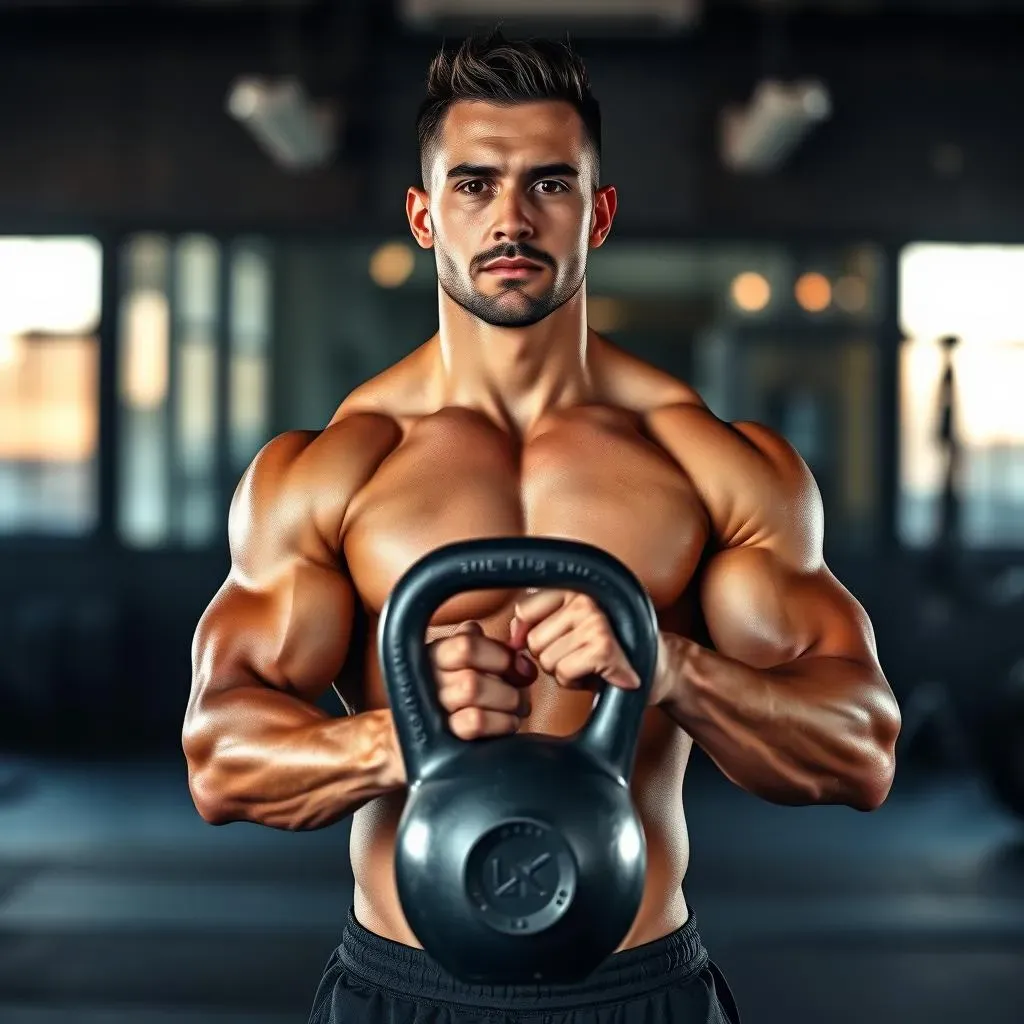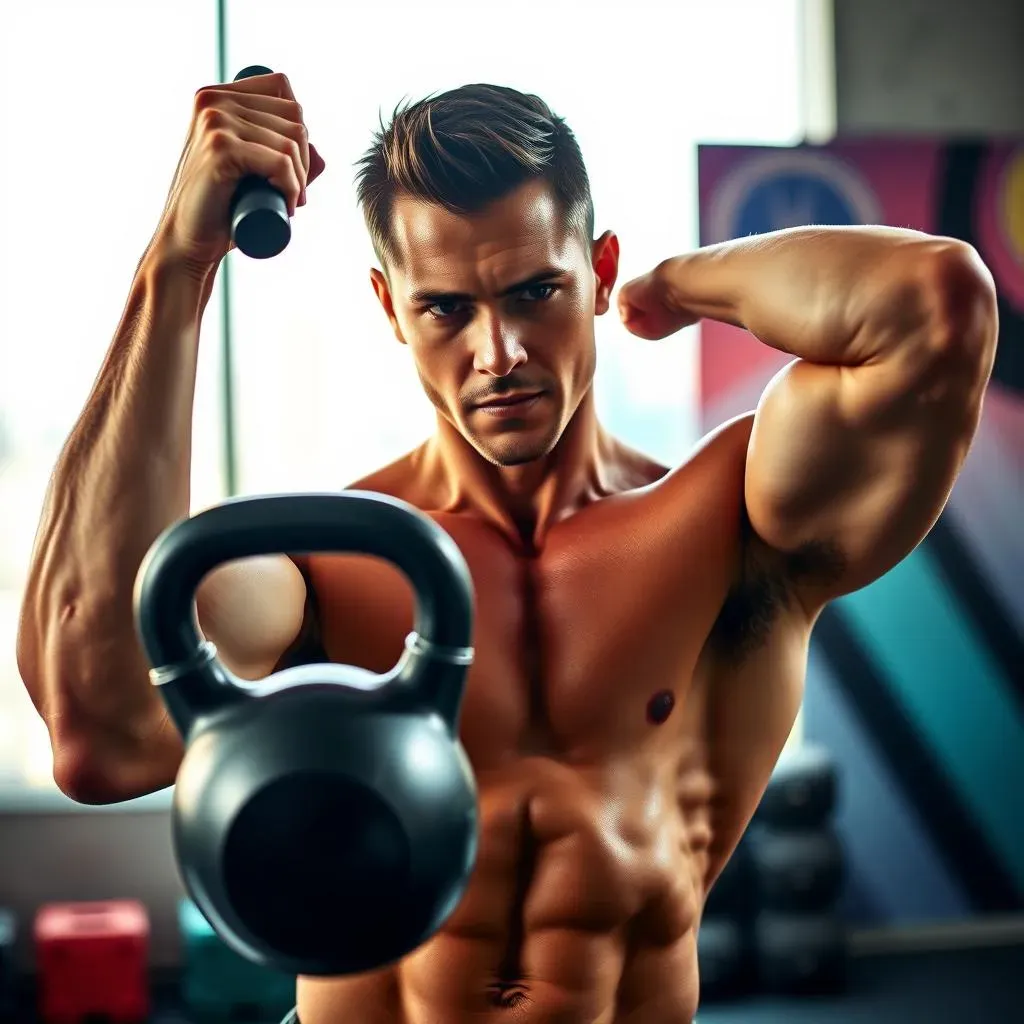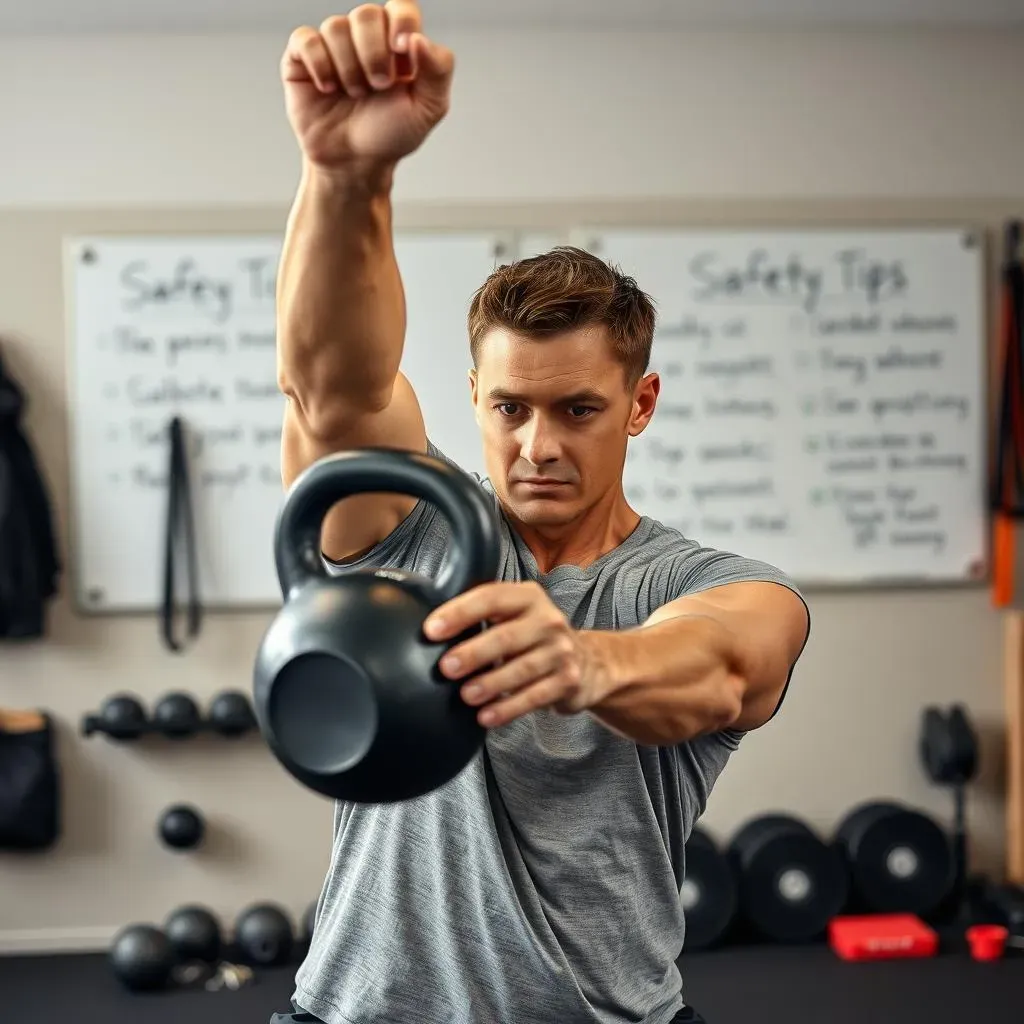Table of Contents
Ready to sculpt a stronger chest and shoulders? Forget the gym machines, we're diving into the world of kettlebells. This isn't just another workout; it's a focused plan to build muscle and power using just one piece of equipment. This article will guide you through a killer 7-exercise routine, designed by kettlebell expert Marcus Filly, that will hit your chest, shoulders, and arms from every angle. We'll break down each move, explain why it works, and offer tips to make sure you're getting the most out of every rep. Whether you’re a kettlebell newbie or a seasoned lifter, this kettlebell chest and shoulder workout will challenge you. We'll cover the essentials, from basic technique to advanced strategies for muscle growth. We'll also talk safety, because nobody wants a shoulder injury. So, grab your kettlebell, and let's get to work!
Kettlebell Basics for Chest and Shoulder Exercises

Kettlebell Basics for Chest and Shoulder Exercises
Why Kettlebells Are Awesome for Upper Body
so you're curious about kettlebells for your chest and shoulders? Awesome choice! These things aren't just fancy doorstops, they're amazing tools for building serious strength and muscle. Unlike dumbbells, the kettlebell's weight isn't evenly distributed, which means your muscles work harder to stabilize the weight. This makes them great for compound movements that engage multiple muscle groups at once. Think of it like this: you’re not just lifting, you’re also controlling and balancing, which activates more muscles compared to a standard dumbbell. It's like getting a two-for-one deal on your workout. So, when you’re doing a kettlebell press, for example, your chest, shoulders, and even your core are all getting a piece of the action.
Plus, kettlebells are super versatile. You can swing them, press them, carry them – the possibilities are pretty endless. This variety helps keep your workouts interesting and prevents your body from getting too comfortable. And let's be honest, variety is the spice of a good workout. You don't want to be stuck doing the same old boring routine, right? Kettlebells bring a dynamic element, making your workout not just effective, but also more fun. This is key because if you enjoy your workout, you’re more likely to stick with it over the long haul. The kettlebell’s unique shape and handle also allow for unique movements that you just can't replicate with other equipment. This opens up a whole new world of exercise options, especially for your chest and shoulders.
Key Kettlebell Moves for Chest and Shoulders
Before we jump into the full workout, let's talk about a few basic kettlebell moves that are super important. We're not going to get too complicated here, just the foundation. First up, is the kettlebell press. This is your bread and butter for chest and shoulder development. It works the chest, front shoulders, and triceps, all at once. There are different variations, like the single-arm press or the double press, each offering a slightly different challenge. Start with a weight that allows you to maintain good form, and gradually increase the weight as you get stronger. Remember, it's not a race, it's about controlled movement and proper technique.
Then, we have the kettlebell push-up. Now, this isn't your regular push-up. By placing your hands on the kettlebell handles, you increase the range of motion, which means more work for your chest. It also demands more stability, activating the small, stabilizing muscles around the shoulders. This variation adds an extra level of difficulty, and will help you build a strong foundation. Make sure to keep your back straight and your core engaged. Lastly, we have kettlebell rows, which are crucial for balanced upper-body development. They target the back, but also engage the rear deltoids and help stabilize the shoulders, which is super important for overall strength and posture. This will make sure that you are not only building your chest and shoulders but also supporting them with a strong back.
Move | Muscles Worked | Why It's Important |
|---|---|---|
Kettlebell Press | Chest, Front Shoulders, Triceps | Builds pressing strength and muscle |
Kettlebell Push-Up | Chest, Shoulders, Stabilizers | Increases range of motion and stability |
Kettlebell Rows | Back, Rear Deltoids, Stabilizers | Balances upper body, supports shoulders |
The 7Move Kettlebell Chest and Shoulder Workout

The 7Move Kettlebell Chest and Shoulder Workout
The Breakdown
Alright, let's get into the good stuff – the actual workout. This isn't just a random collection of exercises, it's a carefully crafted sequence designed to maximize muscle activation and growth. We're talking about a full-body push, pull, and shoulder stability routine that you can bang out with just one kettlebell. It's efficient, effective, and will leave you feeling awesome. The workout is split into three supersets, each targeting different muscle groups. Superset one is all about pushing power, hitting the chest, front shoulders, and triceps. Superset two is for the guns, focusing on biceps using different curl variations. And finally, superset three is all about those shoulders, hitting both the front and back, as well as the chest again. Remember, it's all about working hard, but smart.
Each superset involves performing exercises back-to-back with minimal rest, which cranks up the intensity and gets your heart pumping. Rest between sets, or supersets to catch your breath. You’ll be going from one move to the next, so be sure you're warmed up and ready to go. The key to this workout is not just lifting the weight, but controlling it. Remember, you're not trying to set a world record, you're trying to build muscle. Focus on the quality of each rep, and make sure you're feeling the muscles working. This is where the magic happens, so don't rush through it. It's about that mind-muscle connection, feeling the pump, and pushing yourself to your limits.
Superset | Focus | Exercises |
|---|---|---|
1 | Chest, Shoulders, Triceps | Crush Grip 90/90 Floor Press, Dual Grip Kettlebell Push-up |
2 | Biceps | Horn Grip Curls, Tall Kneeling Hammer Grip Curls |
3 | Shoulders, Chest | Kettlebell Around the Worlds, Kettlebell Chest Fly |
The Exercises
Let's break down each exercise in a bit more detail. First up, we have the crush grip 90/90 floor press. This is a unique chest press variation that really activates the pec muscles. You'll be lying on the floor with your knees bent and holding the kettlebell with your hands, pressing upwards. Next, we move to dual grip kettlebell push-ups. This is where you'll place your hands on the handles of the kettlebells and do push-ups. It adds a bit of instability, working your stabilizing muscles. Then we're doing horn grip curls, where you hold the kettlebell by the "horns" and do your bicep curls. Follow that up with tall kneeling hammer grip curls, where you hold the kettlebell with your palms facing each other. These variations will hammer your biceps. For the shoulder superset, we're kicking it off with around-the-worlds. This is where you move the kettlebell around your head, hitting all the muscles in your shoulder. We're finishing it off with kettlebell chest flys, where you'll be lying on the floor with kettlebells and doing a fly motion. It's a full upper body workout, designed to be done with one kettlebell.
Remember, it's crucial to perform each exercise with proper form. If you're not sure about the technique, check out some videos or ask an expert. It's better to go lighter and focus on form than to try to lift too heavy and risk injury. Pay attention to your body and stop if you feel any pain, especially in your shoulders, elbows, or wrists. This workout is designed to challenge you, not to hurt you. Focus on slow, controlled movements, and really feel the muscles working. This is how you get the most out of every rep, and this is how you get results. Don't rush, be patient, and remember to enjoy the process.
Maximizing Muscle Growth with Kettlebell Training

Maximizing Muscle Growth with Kettlebell Training
So, you've got the workout down, now how do we actually make those muscles grow? It's not just about going through the motions; it's about understanding how to push your body to adapt. One of the key things to remember is progressive overload. This basically means that you need to gradually increase the challenge over time. This could mean lifting a heavier kettlebell, doing more reps, or even reducing your rest time between sets. Think of it like leveling up in a video game; you can’t stay on the same level forever, you need to keep pushing. If you're constantly doing the same thing, your body will adapt, and you'll stop seeing results. So, make sure you're always trying to push past your current limits, but in a safe and controlled manner.
Another crucial factor is the mind-muscle connection. It's not enough to just lift the weight; you need to focus on the muscles you're working. Feel them contract, feel them stretch, and really pay attention to what your body is doing. If you're just going through the motions, you're not going to get the same results. It's like the difference between reading a book and actually living it. When you're truly engaged, you'll get much more out of it. Also, don't underestimate the power of eccentric loading. This is the lowering part of the exercise, when you're resisting the weight. By slowing down this movement, you create more muscle damage, which leads to more growth. It's like the negative feedback loop that your body needs to adapt and improve. So, don't just drop the weight, control it on the way down. It's tough, but it's worth it.
Principle | Description | How to Apply |
|---|---|---|
Progressive Overload | Gradually increasing the challenge over time. | Increase weight, reps, or reduce rest. |
Mind-Muscle Connection | Focusing on the muscles being worked. | Concentrate on each rep, feel the contraction. |
Eccentric Loading | Slowing down the lowering phase of the exercise. | Control the weight on the way down. |
And let’s talk about rest and recovery. You can't just keep working out and expect your muscles to grow. They need time to repair and rebuild. This means getting enough sleep, eating a balanced diet, and not overtraining. It's like trying to build a house without any breaks; eventually, you're going to burn out. Also, make sure you're eating enough protein, which is essential for muscle growth. Think of protein as the building blocks for your muscles. If you're not getting enough, you won't be able to build them. So, make sure you're fueling your body with the right nutrients. And finally, be patient. Muscle growth takes time, and it's not going to happen overnight. Don't get discouraged if you don't see results right away. Just keep putting in the work, and you'll get there. It's a marathon, not a sprint, so enjoy the process.
Safety Tips and Modifications for Your Kettlebell Chest and Shoulder Workout

Safety Tips and Modifications for Your Kettlebell Chest and Shoulder Workout
Listen to Your Body
so you're fired up to crush this workout, but let's pump the brakes for a sec. Safety first, always. Before you even pick up that kettlebell, make sure you're warmed up. A few minutes of light cardio and some dynamic stretches will get your blood flowing and your muscles ready to work. And here’s the golden rule: if something feels off, stop. Don't push through pain, especially in your shoulders, elbows, or wrists. Your body is pretty good at telling you when something's not right, so listen up. It's better to take a break and come back stronger another day than to end up sidelined with an injury. Remember, consistency is key, and injuries can seriously mess with that.
Also, don't get caught up in the "go big or go home" mentality. Start with a weight that you can comfortably control, even if it feels a little too light. It's way better to nail the technique with a lighter weight than to try to lift too heavy and risk injury. Focus on slow, controlled movements and really feel those muscles working. It's not a race, it's about building strength and muscle. And if you're not sure about the proper form, check out some videos or ask an expert. There are tons of great resources out there, so there's no excuse for sloppy form. It's like learning to play an instrument; you need to learn the basics before you can start shredding.
Modifications for Every Level
Not everyone's at the same fitness level, and that's totally fine. This workout is designed to be adaptable, so you can tailor it to your needs. If you're new to kettlebells, start with lighter weights and fewer reps. You can also modify some of the exercises. For example, if the push-ups on the kettlebells are too tough, do them on the floor. Or, if the around-the-worlds are too much for your shoulders, try a simpler shoulder exercise. The goal is to challenge yourself, not to injure yourself. Remember, it’s about progress, not perfection. And don’t feel like you have to stick to the exact routine every time. If you're feeling particularly tired, you can always reduce the number of sets or reps. The most important thing is to stay consistent and keep moving.
If you’re a seasoned lifter, you can increase the weight, reps, or sets to make the workout more challenging. You could also try some more advanced variations of the exercises. For example, you could do the push-ups with your feet elevated, or try the kettlebell press with a single arm. And don't be afraid to experiment with different grip variations or tempos. The key is to keep pushing yourself and to keep your body guessing. Remember, variety is the spice of a good workout. Also, listen to your body; if you're feeling pain, modify or stop the exercise. It’s about finding what works for you and making the workout your own. This is your journey, so make it fun and effective.
Modification | When to Use | How to Modify |
|---|---|---|
Lighter Weight | Beginners or if the weight feels too heavy | Use a lighter kettlebell. |
Floor Push-Ups | Kettlebell push-ups are too difficult | Do push-ups on the floor instead of on the kettlebells. |
Fewer Reps/Sets | Feeling tired or new to the routine | Reduce the number of reps or sets. |
Elevated Feet Push-Ups | Advanced lifters looking for a challenge | Do push-ups with your feet elevated. |
The Importance of Proper Form
Let's be real for a second: proper form is not optional, it's essential. It's like the foundation of a building; if it's not solid, everything else is going to crumble. It's not just about lifting the weight, it's about controlling the movement and engaging the right muscles. If you're not sure about the proper form, check out some videos or ask a trainer. There are tons of great resources available, and it's worth taking the time to learn the basics. It's better to start slow and do it right than to rush through it and risk injury. And remember, it's not about how much weight you can lift, it's about how well you can lift it. Focus on quality over quantity, and you'll see better results.
Pay attention to your body and listen to what it's telling you. If you're feeling any pain, stop the exercise and make the necessary adjustments. And don't be afraid to ask for help if you need it. There are plenty of people who are willing to share their knowledge and expertise. Remember, we're all in this together. And finally, be patient with yourself. It takes time to learn new movements, and it's okay to make mistakes. The most important thing is that you're always trying to improve. So, keep practicing, keep learning, and keep pushing yourself. You've got this!
Wrapping Up Your Kettlebell Chest and Shoulder Journey
You've now got a solid kettlebell chest and shoulder workout in your arsenal. This isn't just about lifting; it's about understanding how to effectively target specific muscles with the right movements. Remember, consistency is key. Don't expect to see massive changes overnight. Keep practicing, focus on proper form, and listen to your body. This 7-move routine is a great starting point, but feel free to adjust it as you progress. Whether you're chasing bigger muscles or just want to feel stronger, this kettlebell workout will help you get there. So, keep swinging, keep pressing, and keep challenging yourself. Your journey to a more powerful upper body is just beginning.